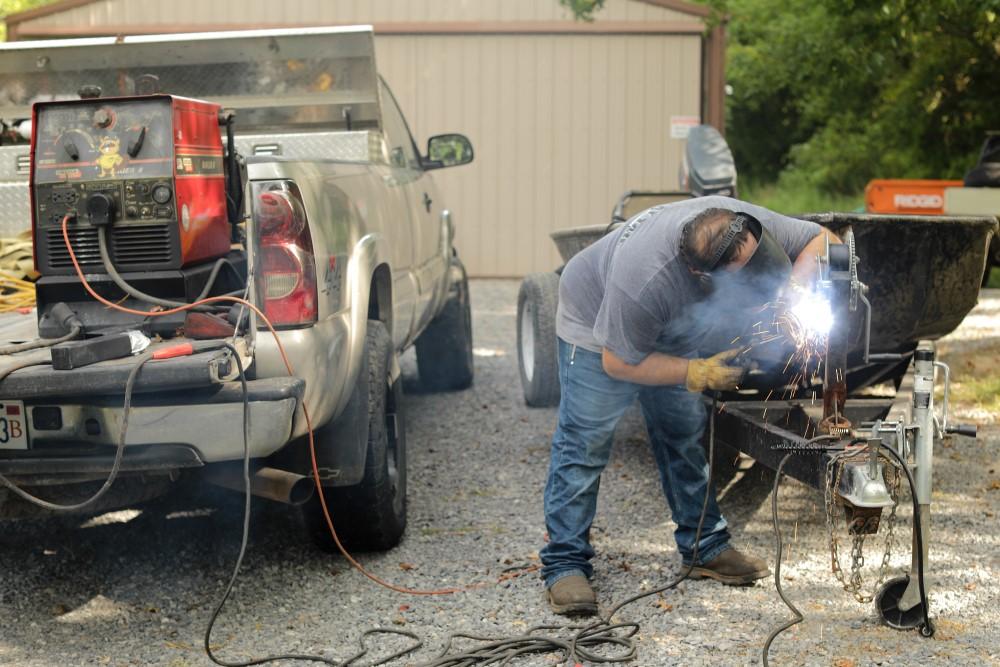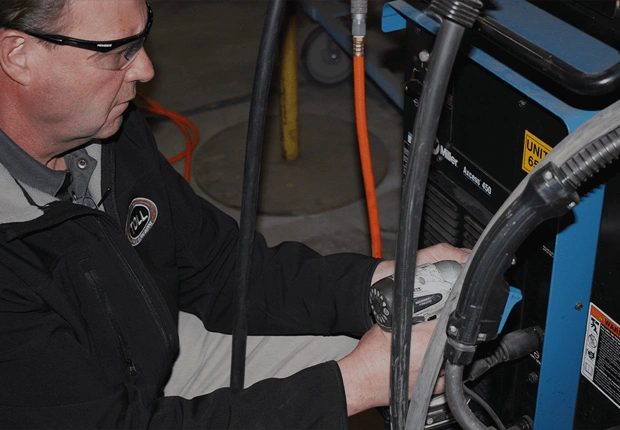Everything about Welding: Secret Insights Into Techniques and Ideal Practices for Success
Welding incorporates a range of methods, each suited for details products and applications. Recognizing these approaches, such as GMAW, SMAW, and TIG, is crucial for achieving excellent outcomes. The appropriate tools and safety and security practices can not be overlooked. As preparation and fixing play critical roles in the welding process, understanding these components can greatly enhance the top quality of the final item. What are the essential aspects that ensure an effective weld?
Comprehending Different Welding Strategies
Welding methods encompass a range of techniques, each suited to specific applications and materials. Among the most usual methods are Gas Steel Arc Welding (GMAW), Shielded Metal Arc Welding (SMAW), and Tungsten Inert Gas Welding (TIG) GMAW, likewise referred to as MIG welding, is popular for its rate and versatility, making it perfect for thin materials. SMAW, or stick welding, is favored for its simpleness and performance in outside atmospheres, especially with thicker steels. TIG welding offers precision and control, making it suitable for complex work and non-ferrous steels (Fabrication). Each strategy has its special advantages and considerations, permitting welders to choose the ideal technique based on the task's demands, product kind, and preferred results. Recognizing these techniques is vital for successful welding
Important Welding Tools and Tools
While numerous welding techniques call for certain skills, the best equipment and tools are similarly essential for accomplishing top quality results. Necessary welding tools includes welding devices, which vary depending upon the method-- such as MIG, TIG, or stick welding. Safety equipment, consisting of aprons, handwear covers, and safety helmets, guarantees safety and security and convenience during the procedure. Additionally, clamps and components help secure materials in position, making sure accuracy in welds. Consumables like welding rods, wire, and securing gas are also important parts that affect the top quality of the weld. Devices such as mills and cutters assist in surface prep work and post-weld finishing, contributing to a specialist end result. Purchasing top quality equipment eventually enhances the performance and performance of welding jobs.
Safety And Security Practices in Welding
Appropriate safety practices are crucial in the welding sector to safeguard workers from prospective dangers. Welders have to put on proper personal protective equipment (PPE), including helmets with proper shading, handwear covers, and flame-resistant garments. Appropriate ventilation is crucial to lower direct exposure to unsafe fumes and gases generated during the welding process. In addition, employees need to be educated in the right handling of welding tools to avoid crashes. Fire precaution, such as keeping combustible materials away from the welding location and having fire extinguishers readily offered, are necessary. Routine inspections of devices and workspaces can assist determine potential hazards before they cause crashes. By adhering to these security techniques, welders can develop a more secure working environment and decrease dangers connected with their profession.
Preparing Products for Welding
Preparing products for welding is an important step that substantially influences the high quality and stability of the end product (Montana Mobile Welding and Repair Belgrade Welding). Proper preparation involves cleaning the surfaces to remove contaminants such as dust, oil, and rust, which can jeopardize the weld. Techniques such as grinding, fining sand, or making use of solvents are frequently used to achieve a tidy surface area. In addition, making sure that the materials fit together snugly is vital; voids can bring about weak welds. It's additionally important to think about the positioning and positioning of the elements, as this will influence the simplicity of welding and the final outcome. Lastly, choosing the ideal filler product and ensuring compatibility with the base steels is crucial for attaining solid, sturdy welds
Tips for Achieving High-Quality Welds
Accomplishing premium welds requires interest to detail and adherence to finest techniques throughout the welding procedure. Appropriate joint preparation is vital, guaranteeing surfaces are complimentary and clean from impurities. Selecting the suitable filler product and welding technique based upon the base steels is vital for optimal bonding. Maintaining consistent travel rate and angle while welding can advertise and avoid flaws uniformity. Additionally, regulating warm input is important; extreme heat can result in warping and damaged joints. If needed, consistently evaluating the welds throughout the procedure enables for instant changes. Utilizing appropriate post-weld therapies, such as cleaning and stress alleviation, can improve the longevity and honesty of the weld, eventually ensuring an effective result.
Troubleshooting Common Welding Issues
Welding typically provides obstacles that can impact the top quality and integrity of the end product. Common problems such as porosity, inconsistent weld beads, and getting too hot can develop, each requiring particular troubleshooting techniques. Recognizing these issues is important for welders to boost their skills and achieve ideal outcomes.
Porosity Troubles Clarified
Although porosity can usually be neglected, it remains a critical problem in welding that can jeopardize the stability of an ended up item. Porosity describes the visibility of little gas pockets within the weld grain, which can compromise the joint and lead to early failing. This trouble usually occurs from impurities, moisture, or incorrect protecting gas coverage during the welding process. To mitigate porosity, welders should verify that the base materials are dry and tidy, use proper shielding gases, and keep regular welding parameters. Frequently evaluating the tools and environment can additionally aid determine potential concerns prior to they show up in the weld. Attending to porosity properly is essential for achieving solid, sturdy welds that satisfy high quality requirements.

Irregular Weld Beads
Irregular weld beads can significantly impact the top quality and stamina of a completed product. Numerous aspects add to this concern, including improper travel rate, incorrect amperage setups, and irregular electrode angles. When the welder relocates also rapidly, a grain might appear slim and do not have penetration, while relocating too slowly can trigger extreme buildup. In addition, utilizing the wrong amperage can cause either undercutting or too much spatter, both of which compromise weld honesty. The welder's technique, such as irregular torch activity, can additionally lead to uneven bead appearance. To alleviate these problems, welders need to concentrate on maintaining consistent, controlled activities and making certain proper devices settings to accomplish uniformity in their welds. Consistency is vital to accomplishing strong and reliable welds.
Overheating and Warping Issues
Excessive warmth during the welding process can cause substantial getting too hot and warping problems, impacting the structural integrity of the work surface. These troubles often manifest as distortion, which can compromise positioning and fit-up, making more setting up challenging. Factors adding to overheating consist of the option dig this of welding specifications, such as voltage and travel speed, along with the kind of product being bonded. To minimize these concerns, welders need to preserve regular travel i thought about this rate and proper warm input while keeping an eye on the work surface temperature level. In addition, pre-heating or post-weld heat treatment can assist relieve stresses triggered by fast cooling - Welding. Routine examination and adherence to finest practices are important in protecting against overheating and making sure the durability and integrity of bonded structures
Regularly Asked Concerns
What Are the Career Opportunities in the Welding Sector?
The welding industry provides varied occupation chances, including placements as welders, instructors, inspectors, and engineers. Experts can operate in production, building, aerospace, and automobile markets, profiting from solid need and competitive incomes in various functions.
Just How Can I Enhance My Welding Speed Without Sacrificing Quality?
To enhance welding rate without giving up top quality, one ought to practice efficient techniques, preserve devices, maximize settings, and improve hand-eye control. Regular training and seeking responses can additionally greatly contribute to attaining faster, high-quality welds.
What Qualifications Are Offered for Welders?
Countless qualifications exist for welders, including those from the American Welding Culture (AWS), the National Facility for Construction Education And Learning and Research (NCCER), and various industry-specific companies. These qualifications boost employability and show skill proficiency.
Exactly How Does Welding Affect the Qualities of Metals?
Welding affects the properties of steels by altering their microstructure, which can cause adjustments in toughness, solidity, and ductility. Heat input and air conditioning rates throughout the process significantly influence these material qualities.
Can I Bonded Dissimilar Metals With Each Other?
